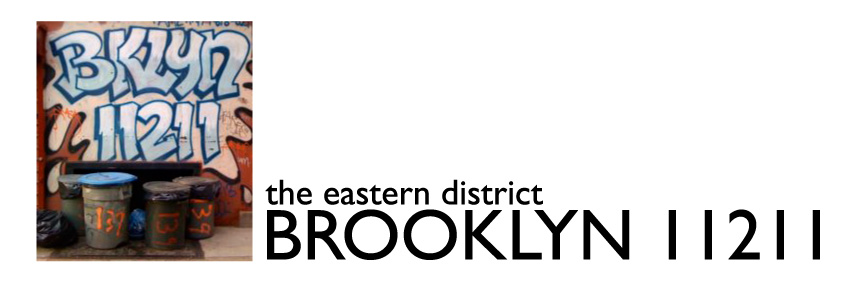Keramos Hall has been getting a lot of accolades and awards for its recent restoration, and rightfully so. Untapped New York has a great collection of photos – it is almost possible to ignore the CVS.
Restoration of Keramos Hall
Bushwick Bars Given Midnight Curfew on Sundays by Community Board
Suddenly, CB4 in Bushwick seems to going through a lot of the growing pains that CB1 went through 10 years ago or more. Around that time, CB1 tried to institute a moratorium on all new liquor licenses in the Northside (yes, nightlife was once primarily restricted to the Northside). That had no effect, and it is pretty much guaranteed that Sunday curfews will have the same effect.
If CB4 wants to control hours or other aspects of operations, they need to negotiate those restrictions with new licensees and get those restrictions into the methods of operation of the liquor licenses. Just say no doesn’t work with SLA.
[via Wyckoff Heights]
Buildings We Love (And Would Hate to Lose)
Preservation Greenpoint and GWAPP are taking names.
A Brooklyn Corner
On the Thursday morning before Christmas, about fifteen women, mostly Latina but some Eastern European, stand scattered on a curved asphalt shoulder overlooking the Brooklyn-Queens Expressway.
Fascinating look at the day-labor market for female day laborers in South Williamsburg, including both the women – mostly Polish and Latina – who are being hired, and the Hasidic women doing the hiring.
[via Brownstoner]
Jailed for 2 Decades in Rabbi’s Death, Unjustly, Prosecutors Say
[David] Ranta was convicted in May 1991 and sentenced to 37.5 years in maximum-security prison, where he remains to this day.
He is almost certainly not guilty.
Sad tale of justice gone completely wrong. Ranta will be set free, but whether any of those responsible for this travesty will ever suffer any consequence seems pretty doubtful.
NYC’s Pneumatic Tube Mail Network
From 1897 to 1953, 27 miles of underground pneumatic tubes looped through the post offices of Manhattan (and out to Brooklyn). Letters too 15 to 20 minutes to travel from Herald Square to the Triborough post office, the northernmost in the system.
I’ve seen remnants of building-wide pneumatic systems, and knew that there was wider service, but never knew it was this extensive (of course, NYC was nothing compared to Paris’ 269-mile system).
Affordable Lender CPC Gets $250M Boost
Good for them (and good on Citigroup for putting up the money). CPC let itself get distracted by being thinking they should be a developer, which they never were. Their core role of providing funding for affordable housing is too important:
Experts, such as president of the city Housing Development Corporation Marc Jahr, see CPC’s focus on small, four-story walk-ups and six-story elevator buildings as essential to revitalizing the city. “The fate of a neighborhood resides in the fate of those buildings,” Jahr told the Journal.
How Much More Williamsburg Development Can the L Train Handle?
According to the Observer (and the MTA), a lot. CBTC upgrades will let the line operate at a theoretical capacity of 26 trains per hour, or one train every 2 minutes and 20 seconds or so (current capacity is 19 trains an hour, or one every three minutes or so). That represents a 38% increase in capacity, which is great considering the continued pace of development between Bedford Avenue and Myrte-Wyckoff.
At least until there is a sick passenger.
Urban Outfitters and Anthropologie to Williamsburg?
According to Crain’s, Anthropologie is going to join Whole Foods (and possibly Joe Fresh, Citibank and New York Sports Club) next door to Duane Reade, HSBC and Retro Fitness, which I guess has the advantage of concentrating all the boring (and largely redundant) retail on one block.
But that’s not all… according to Crain’s Anthropologie’s corporate sibling Urban Outfitters is coming to North 6th Street, next door to American Apparel (another match made in heaven).
Meanwhile:
J. Crew has also been rumored to be looking in the neighborhood
Why do I get the feeling J. Crew is the new Apple Store?
How Will Developers Treat Historic Buildings in Bushwick and Ridgewood?
Nice to see that someone is thinking about historic buildings in Ridgewood and Bushwick.
There is a lot there, and although some of it is designated (mainly in Ridgewood) there is a lot that isn’t. As Wyckoff Heights notes, a lot of the neighborhood on the Brooklyn side is zoned R6, and lacks the contextual height limits of the R6B zone on the Queens side. The density differences between R6 and R6B are usually marginal, but the potential impact on a neighborhood of relatively uniform lower-height buildings can be huge. This issue was called out in a 2011 preservation plan that my students did for Bushwick Avenue. The studio focused on the westernmost end of Bushwick (primarily the avenue itself), but identified the disparity of existing building heights vs. allowed zoning as a looming problem [pdf]. To the west, Bed-Stuy has largely been “contextually” rezoned, as has Ridgewood. But the heart of Bushwick is ripe for pop-ups and finger buildings galore.
